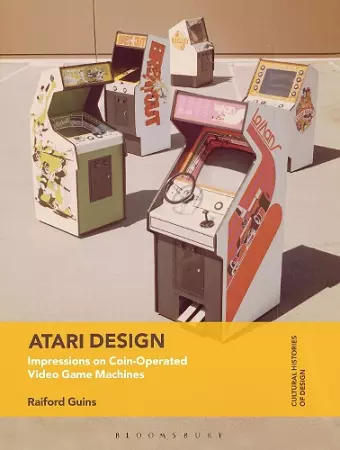Atari Design
Impressions on Coin-Operated Video Game Machines
Format:Paperback
Publisher:Bloomsbury Publishing PLC
Published:12th Nov '20
Currently unavailable, our supplier has not provided us a restock date

Draws on archival material and interviews with designers, to give a rich historical study of the Atari arcade video game cabinet.
Drawing from deep archival research and extensive interviews, Atari Design is a rich, historical study of how Atari’s industrial and graphic designers contributed to the development of the video game machine.
Innovative game design played a key role in the growth of Atari – from Pong to Asteroids and beyond – but fun, challenging and exciting game play was not unique to the famous Silicon Valley company. What set it apart from its competitors was innovation in the coin-op machine's cabinet. Atari did not just make games, it designed products for environments.
With “tasteful packaging”, Atari exceeded traditional locations like bars, amusement parks and arcades, developing the look and feel of their game cabinets for new locations such as fast food restaurants, department stores, country clubs, university unions, and airports, making game-play a ubiquitous social and cultural experience. By actively shaping the interaction between user and machine, overcoming styling limitations and generating a distinct corporate identity, Atari designed products that impacted the everyday visual and material culture of the late 20th century.
Design was never an afterthought at Atari.
Atari Design is an original and inspiring monograph reminding us that histories of video games (and computing) should not be reduced to programs and electronics only; they should also address design in its traditional sense. * Technology and Culture *
Guins manages to break through the glitz and noise and find a fresh, innovative approach toward the history of gaming and design. What is extraordinary about Atari Design is the provocative way he argues that we should pay more attention to the material apparatus of early video game designs, notably the cabinetry of these products designed for amusement. He provides a unique and enlightening examination of the interior - and exterior - of these designs. Historians and many nonspecialists will find this book not only enjoyable but also enlightening. -- Elizabeth Guffey, Professor of Art and Design History, State University of New York, USA
Atari Design is a major contribution to design history and to our understanding of the phenomenal culture of video game history. It is scrupulously researched and breezily erudite. It is a tale free of design heroics which instead brings alive the distributed labours of designers who until now have remained anonymous. It is also a supercharged ride of a book. Who knew that a history of arcade game cabinets could be this much fun? -- Ben Highmore, Professor of Cultural Studies (Media and Film), University of Sussex, UK
By merging the words Atari and Design in his book's title, Raiford Guins throws down the gauntlet for future historians, curators, and interpreters of interactive media. His lucidly argued and meticulously researched history of Atari arcade games demonstrates why an electronic game is not just the sum of its hardware, code base, motion graphics, interfaces, or modes of interaction, but also encompasses the housings that stage interactive media in the built environment, transform games into objects of experience, and weave them into the design of interiors from bars to galleries to homes. -- Jeffrey Schnapp, Harvard University, USA
Atari Design rescues the coin-operated arcade game from 1970s nostalgia, decoupling the wood veneer of Pong and the supergraphic panels and semi-immersive cabinet of Tempest from the jellybean styling of the AMC Pacer automobile and the avocado green and burnt orange kitchens of the era. Instead, author Raiford Guins cross-pollinates design history with game studies, reminding us that software is always grounded in hardware. Featuring interviews with pioneering if little recognized designers from a range of disciplines, Atari Design offers an expansive sense of what arcade games meant and how they operated in the world. By interrogating what he terms “the material factors constitutive of interactability,” Guins conjures an apparatus theory for the 21st Century. -- Peter Lunenfeld, Vice Chair and Professor, UCLA Design Media Arts, USA
More than a decade before Apple conceived of “the computer for the rest of us,” Atari was the first Silicon Valley technology company to direct its efforts toward the general population. If it was to capture—indeed, to define—a broad market for its coin-operating gaming machines, Atari needed an approach in which cabinets and graphics were as important as circuits and screens. By demonstrating that industrial and graphic design was as important to Atari’s success as engineering and programming, Raiford Guins’ detailed, densely researched history represents a contribution to design history generally and to the history of game design in particular, which has tended to focus on narrative and visual effects and to dismiss the physical enclosures of the early games as a cosmetic afterthought. To the contrary, “The coin-op cabinet did not simply contain. It was a medium of communication…” -- Barry Katz, Professor of Design, California College of the Arts, USA
ISBN: 9781474284554
Dimensions: 244mm x 186mm x 4mm
Weight: 640g
280 pages